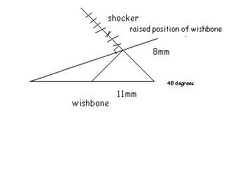
Front shock bottom bracket position
alfasudsprint - 3/7/04 at 01:56 PM
How can I calculate this position relative to the chassis? What I have so far is: with top maount on underside of top chassis rail, and lower bones
parallel to ground, the shock (uncompressed) is in position x (pretty close to lower pivot-good for reducing bending of bone according to otehr post)
then with full car weight on the two front springs they compress 8mm. (Gaz shocks from MK, springs 325 and 174lb). So, the question is how much do I
move the bracket horizontally towards the chassis to maintain parallel lower bones but allow for the 8mm loss in 45 degree (approx) height?
Having read all posts connected with this, I haven't found any reference to this...
On another point, I am using Lada parts, uprights and brakes, gearbox...the uprights are of a very different design to the cortina ones, principally
in that the bottom pivot is much further away from the centre than the top, the exact opposite to the cortina (only discovered after welding brackets
on etc :mad meaning that the bottom wishbones were at a ridiculous angle down to the wheel. Also, the pivots are not vertically aligned, when looked
at along the length of the car. Many problems. I am only heartened by the fact that others have had problems with front suspension positioning! Not
becusae I am sadistic...it just means I have to get on and sort it out! In this case I turned the upright upside down, meaning that with the pivots
being offset, the wishbone lengths are wrong, with about 15 degreees of positive camber! So now i am making new wishbonmes.
meaning that the bottom wishbones were at a ridiculous angle down to the wheel. Also, the pivots are not vertically aligned, when looked
at along the length of the car. Many problems. I am only heartened by the fact that others have had problems with front suspension positioning! Not
becusae I am sadistic...it just means I have to get on and sort it out! In this case I turned the upright upside down, meaning that with the pivots
being offset, the wishbone lengths are wrong, with about 15 degreees of positive camber! So now i am making new wishbonmes.
Any observations about how to calculate the lower shock position most welcome.
Tim
JoelP - 3/7/04 at 03:28 PM
roughly 11mm in, assuming that the shocker is at 45 degress. route of 2*8^2.
route of 2*8^2.


Rescued attachment zippy123.JPG
alfasudsprint - 3/7/04 at 04:58 PM
Thanks Joel.
MikeP - 4/7/04 at 12:49 AM
Are the spring mounts adjustable? If they are, you should try to mount the shock bracket so that the wheel travel from ride height (which I suspect
is limited by the shocks) has 2/3 movement bump, 1/3 droop.
I'm not sure, but it sounds like you're saying the chassis ride height with the Lada parts will be lower than with the cortina? The ride
height is pretty adjustable at the rear, so you can design it to suit your uprights, assuming you're wheels are big enough to keep the sump from
hitting the ground.
Des Hammill in his book suggests the front lower control arms can slope down to the wheels as much as 3/4". This is measured from the center
line of the chassis pivots to the center of the outer ball joint, not necessarily the control arm itself. The uppers should slope up toward the wheel
at least 3 to as much as 10 degrees (according to Hammill).
HTH, good luck!
 meaning that the bottom wishbones were at a ridiculous angle down to the wheel. Also, the pivots are not vertically aligned, when looked
at along the length of the car. Many problems. I am only heartened by the fact that others have had problems with front suspension positioning! Not
becusae I am sadistic...it just means I have to get on and sort it out! In this case I turned the upright upside down, meaning that with the pivots
being offset, the wishbone lengths are wrong, with about 15 degreees of positive camber! So now i am making new wishbonmes.
meaning that the bottom wishbones were at a ridiculous angle down to the wheel. Also, the pivots are not vertically aligned, when looked
at along the length of the car. Many problems. I am only heartened by the fact that others have had problems with front suspension positioning! Not
becusae I am sadistic...it just means I have to get on and sort it out! In this case I turned the upright upside down, meaning that with the pivots
being offset, the wishbone lengths are wrong, with about 15 degreees of positive camber! So now i am making new wishbonmes. 
